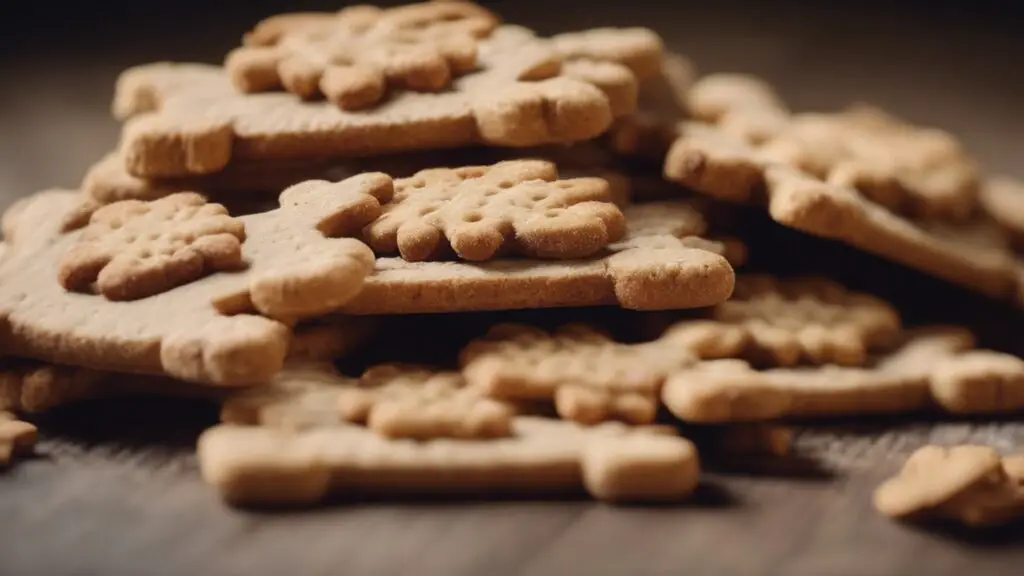
The best way to use dog biscuits is as a reward for good behavior or successful training sessions. Break biscuits into smaller pieces to manage your dog’s calorie intake.
Dog biscuits are more than just treats; they are crucial in reinforcing positive behavior and strengthening the bond between you and your furry friend.
These snacks are a motivational tool for obedience training and help maintain your dog’s dental health.
Moderation is key, as excessive treatment can lead to weight gain. Incorporating biscuits into playtime or using them as a training aid can keep your dog engaged and eager to learn.
Remember to choose high-quality dog biscuits that cater to your pet’s dietary needs and preferences, ensuring a happy, healthy companion.
The Role of Dog Biscuits in Canine Nutrition
Dog biscuits play more than just a role in training; they are crucial for nutrition. A well-chosen biscuit offers vitamins, minerals, and energy. Understanding this role helps maintain a balanced diet for pups.
Key Nutritional Components in Treats
Treats with high-quality ingredients support health. Look for these nutrients:
- Protein: Builds strong muscles.
- Fats: Provides energy.
- Fibers: Aids in digestion.
- Vitamins: Supports overall wellness.
- Minerals: Strengthens bones and teeth.
Caloric Impact on Daily Diet
Treat calories can add up. Follow these tips to avoid weight gain:
- Check biscuit calories.
- Limit treats to 10% of daily intake.
- Adjust meals to account for treats.
Remember: Always choose quality dog biscuits that complement your pup’s meals.
Choosing the Right Biscuits for Your Dog
Dogs love a good treat, and biscuits can be the perfect reward. Picking the right biscuits ensures they stay happy and healthy. Consider your dog’s needs, preferences, and dietary restrictions.
Size and Breed Considerations
Biscuit size matters, just like the size of your dog. Smaller breeds need tinier, easy-to-chew biscuits. Larger breeds can handle bigger, harder biscuits. It helps them with tooth cleaning action as they munch.
Ingredients to Look for and Avoid
High-quality ingredients make the best biscuits. Lean meats, whole grains, and veggies are good. Avoid anything with artificial flavors, colors, or preservatives.
Remember, no chocolate or xylitol, as these are toxic to dogs.
| Size of Dog | Recommended Biscuit Size | Ingredients to Include | Ingredients to Avoid |
| Small | Small, soft biscuits | Lean meats, rice, oats | Chocolate, Xylitol, BHA/BHT |
| Medium | Medium-sized, crunchy | Fruits, veggies, whole grains | Artificial additives, salt, sugar |
| Large | Large, durable biscuits | Lean proteins, healthy fats | Fillers like corn and soy, artificial sweeteners |
- Look for biscuits with real meat or fish as the first ingredient.
- Avoid items with a long list of unrecognizable components.
- Biscuits with whole-food ingredients are superior.
- Check for any allergens your dog may have.
- Assess your dog’s size and chewing habits.
- Read labels for safe, nutritious ingredients.
- Pick size-appropriate biscuits.
- Avoid biscuits with harmful substances.
Training With Treats: Maximizing Effectiveness
Dogs love snacks, and trainers love progress. When used correctly, dog biscuits can be powerful tools. They reinforce good behavior.
This segment will uncover the secrets to using dog biscuits effectively during training sessions. Aim for a well-behaved furry friend, not just a treat-driven one.
Timing Rewards for Positive Reinforcement
Getting the timing right is key. Reward your dog the moment they follow a command. This helps them connect the action with the treat. Use these steps:
- Issue a command: Be clear and consistent.
- Wait for the action: Patience is essential.
- Instant reward: Give a biscuit right after the obeyed command.
Repeat this process. It makes training stick. Your dog learns that listening equals tasty rewards.
Limiting Treats to Encourage Obedience
Treats are like gold to dogs but don’t overuse them. Too many can lead to dependency. Follow these tips:
- Quality over quantity: Choose healthy, high-value biscuits.
- Keep them guessing: Don’t give a treat every time.
- Alternate rewards: Use praise or playtime as well.
- Decrease over time: Gradually reduce the number of treats.
This approach fosters obedience. Your dog should listen, not just for a biscuit.
Creative Ways to Incorporate Dog Biscuits Into Playtime
Playtime with your puppy is more than fun and games. It’s a chance to bond and teach valuable skills.
Let’s explore some delightful ways to use dog biscuits during these special moments.
Interactive Puzzle Toys
Interactive puzzle toys spark your pup’s curiosity. They combine play with treats, offering a rewarding challenge. Here’s how:
- Choose a puzzle toy suitable for your dog’s size and intelligence level.
- Insert dog biscuits into the puzzle sections.
- Encourage your furry friend to move parts of the toy to discover the treats.
- Cheer them on as they figure out the solution.
Hide and Seek Games
Hide-and-seek games keep dogs active and mentally sharp. Try these steps:
- Hide biscuits around the house or yard while your dog waits.
- Release your dog with an excited “Find the treats!” to start the hunt.
- Clap and praise your dog each time they find a hidden biscuit.
- Keep hiding spots within your dog’s reach to prevent frustration.
Dog Biscuits and Oral Health
Dog biscuits are more than just treats. They play a crucial role in your pet’s dental health. The right biscuit can help scrape away plaque.
It can also massage the gums. Choose specialized dental treats for the best oral care.
Dental Treats vs. Regular Biscuits
Dental treats and regular dog biscuits differ.
| Dental Treats | Regular Biscuits |
|---|---|
| Designed to clean teeth | Mostly for rewarding |
| May contain special ingredients | Often include grain and fillers |
| Varied shapes for gum health | Simple shapes |
Choose dental treats to fight tooth decay and bad breath. Look for features that boost oral care.
Best Practices for Preventing Plaque and Tartar
Protect your dog’s teeth with these best practices:
- Daily dental treats: Give one treat every day.
- Right size: Match the treat size with your dog’s breed.
- Clean water: Fresh water should always be available.
- Regular checkups: Visit the vet for dental checks.
Prevention is key. A routine keeps your dog’s teeth healthy.
Homemade vs. Store-bought Dog Biscuits
Dog biscuits are a popular treat for our furry friends, but choosing between homemade and store-bought can be tough.
Understanding the benefits and downsides of each option helps pet owners make the best decision.
Pros and Cons of Making Your Own
Creating dog biscuits at home means control over ingredients and ensures freshness. It can strengthen the bond between pet and owner, too.
On the downside, homemade treats demand time and cooking skills. They can also lack certain nutritional elements if not carefully crafted.
Here are the points to consider:
- Ingredient quality: Use wholesome, pet-safe components.
- Time investment: Prepare for baking and cleaning up.
- Nutritional balance: Consult a vet for recipe advice.
Evaluating Commercial Treat Quality
It’s critical to scrutinize store-bought biscuit quality:
| Quality Indicator | Details to Check |
|---|---|
| Ingredients List | Look for natural, whole-food inclusions. |
| Brand Reputation | Choose brands with positive reviews and transparent practices. |
| Nutritional Info | Ensure balanced nutrients in line with your dog’s dietary needs. |
| Expiration Date | Pick the freshest, with ample time before the product expires. |
Read labels carefully:
Avoid products with artificial additives or unknown substances.
Check for recalls:
Stay updated on product safety issues.

Frequently Asked Questions
How Do You Use Dog Biscuits?
Use dog biscuits as treats during training or as rewards. Offer them in moderation, aligning with a balanced diet. Always ensure fresh water is available when giving your dog biscuits.
How Many Dog Biscuits Should a Dog Have a Day?
Dogs should typically have 1-3 biscuits daily, based on their size and dietary needs. Treats should not exceed 10% of their total daily calories. Always consult with your vet for personalized advice.
What Are Dog Biscuits Good for?
Dog biscuits offer nutritional benefits, support dental health, and aid in training as a reward for good behavior. They also help maintain strong bones and a healthy coat for dogs.
Should You Dehydrate Dog Biscuits?
Dehydrating dog biscuits is optional but can improve their shelf life and crunchiness. Always follow the recipe’s moisture content guidelines for safety.
What Are the Health Benefits of Dog Biscuits?
Dog biscuits can enhance dental health, provide vital nutrients, and promote digestion in dogs when used as a part of a balanced diet.
Conclusion
Embracing the versatility of dog biscuits can elevate your furry friend’s health and training routines. Pet owners unlock a world of benefits by mixing creativity with nutritional insights.
Remember, selecting the right treats and usage matters. Let’s ensure happy, healthy pups with smart biscuit practices.
Share your favorite tips and watch tails wag!






